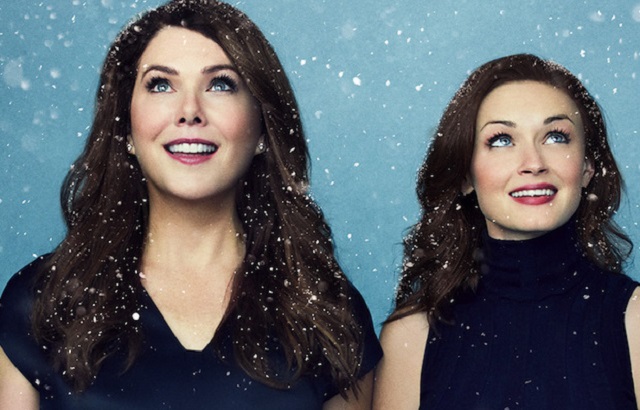When it comes to judging the success of revivals or reunions of dormant television shows, the litmus test is simple: Does it justify its existence? Not all of them do. (Sorry, Fuller House.) Gilmore Girls: A Year in the Life does that, for sure. We’re better off having it.
But Netflix’s Gilmore Girls revival does a lot more than simply justifying its own being, even though at times it feels almost anachronistic compared to today’s style of television. That’s not necessarily a flaw, and is probably a necessity. This show wouldn’t be back if not for the massive nostalgia felt by the fanbase.
That means there’s an inherent amount of fan service required (it’s there, and handled fairly well), and it also means that there’s limited leeway in the presentation and formula of the show. It’d be very weird if Gilmore Girls returned and attempted to ape the more cinematic look of modern dramatic television, or indeed modern comedic television.
https://youtu.be/fTnU5MG5Edw
Fortunately, the successes of A Year in the Life demonstrate that the Gilmore Girls formula is timeless. Fans of the series have been pining for closure ever since the show’s final season, which ran without the involvement of series creator/showrunner/lifeblood Amy Sherman-Palladino. Some shows can survive a loss and continue relatively unchanged, but Gilmore Girls was such a personal vision, with idiosyncratic rhythms and a unique approach to dialogue that proved impossible to replicate without her guiding the way.
It’s not a stretch to say that Gilmore Girls in the wrong hands could be an insufferable affair. The cast is obviously incrediby talented, and carried the weight of the final season, but much like The West Wing after the loss of Aaron Sorkin, it was clearly not the same show. So, with Sherman-Palladino back at the helm, and the first trip back to Stars Hollow since 2007 available for anyone who wants to take the ride, thanks to Netflix, was it worth the wait?
Yes.
[This is mostly devoid of actual spoilers, as the show wastes no time giving us updates on the situations of the main characters, and I won’t mention any plot developments, per se. But if you prefer to be wholly, completely unspoiled, you should probably just be binging this right now. Go ahead, watch at work, your boss says it’s fine.]
Structured as four seasonal episodes, roughly 90 minutes each, the show picks up in Winter and takes us through Fall in an eventful year for Lorelai, Rory, Luke, and Emily, the four main characters of this version of the show. (Don’t worry, fans hoping to see characters not mentioned yet. You’ll be covered.)
https://youtu.be/Hjqrr7nss3s
The death of Edward Herrmann, (and by extension, Richard Gilmore, whom Herrmann so ably played) is felt throughout the revival. Emily is struggling to process the loss in more obvious ways than Lorelai or Rory, and it opens up new wounds between Emily and her daughter. Lorelai is struggling with her own personal satisfaction; she and Luke live together, but aren’t married. The Dragonfly Inn is fine, but unchanged. She’s satisfied with just about everything, but just can’t help but wonder if she could be doing more.
Luke, meanwhile, bristles at the idea of change. His irascibility has always been a defining character trait, of course, but whereas before it felt more as though it was emblematic of dissatisfaction, now, having gotten just about everything he ever wanted, he doesn’t want to lose any of what he’s gained.
Rory, meanwhile, is unmoored. Dating Paul, a literally forgettable boyfriend (there’s a running gag similar to Michael Bluth’s constant Ann-related forgetfulness on Arrested Development), she’s cycling through various career opportunities, hoping for the right fit, from a potential book deal to GQ to a startup website.
It’s an identifiable struggle on one hand, but on the other, there’s never a real sense that Rory is in trouble, or in danger. When she’s jetting back and forth to London, with an insanely wealthy grandmother, a very successful mother, and a doting Luke, why should we worry that she doesn’t have her life figured out in her early 30s? She claims she’s broke in one scene, repeatedly, and it’s seemingly written to be taken seriously. But it’s impossible to hear a character like Rory say something like that and take it seriously.
https://youtu.be/kGGNNSmGDpU
As has always been the case, Gilmore Girls is at its best with Rory and Lorelai together. They named the show Gilmore Girls for a reason. And when the show puts them in the same scenes, it’s in those moments that it recaptures just about all of its peak magic. In others, though, it can drag; the runtimes allow for things like an extended version of a Stars Hollow musical that is supposed to be “so bad it’s funny and entertaining,” but in reality is just, well, bad.
Some of the more self-aware fan service is better than others. There’s a running gag where Lorelai hosts celebrity chefs at the Dragonfly that’s not as funny as even that humorless synopsis would suggest. (Plus, unless I missed it, the final cut didn’t contain the scene where Lorelai asked Rory if John Oliver would think she’s hot.)
But despite its shortcomings, Gilmore Girls is a world worth revisiting. There are scenes of real emotional depth, playing upon the deep history that the audience has with these characters, and the time that has passed for us, as well as the show’s universe. And most importantly, it’s a way for the show to go out on the terms of its creator. As fans of the show likely know, Sherman-Palladino once said that she always knew what the last four words of the series would be.
At the end of “Fall,” the final episode of this revival, we get those four words.
It’s not spoiling anything to say that they’re at once surprising and obvious.








Comments are closed.